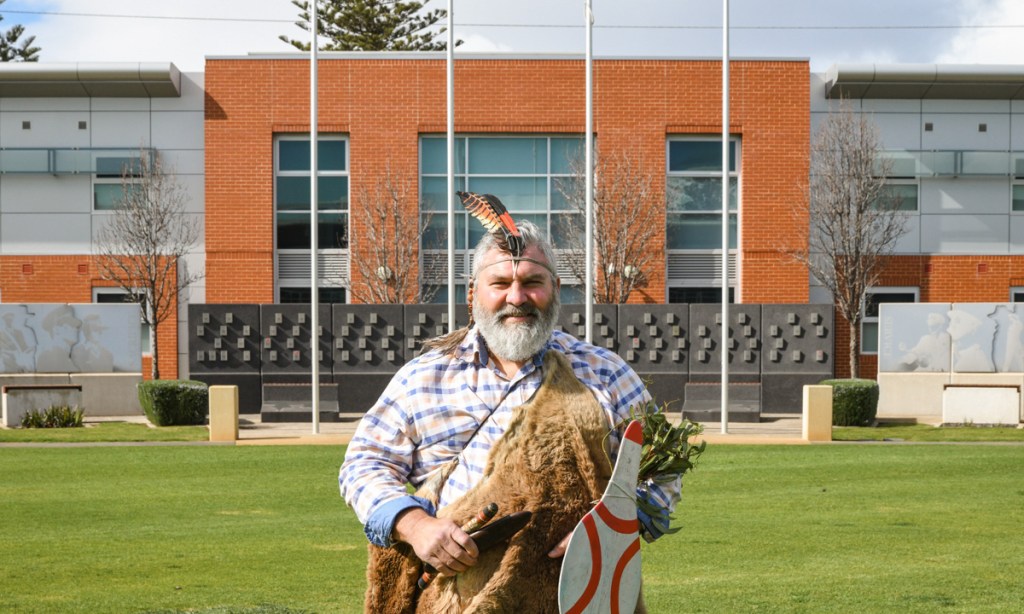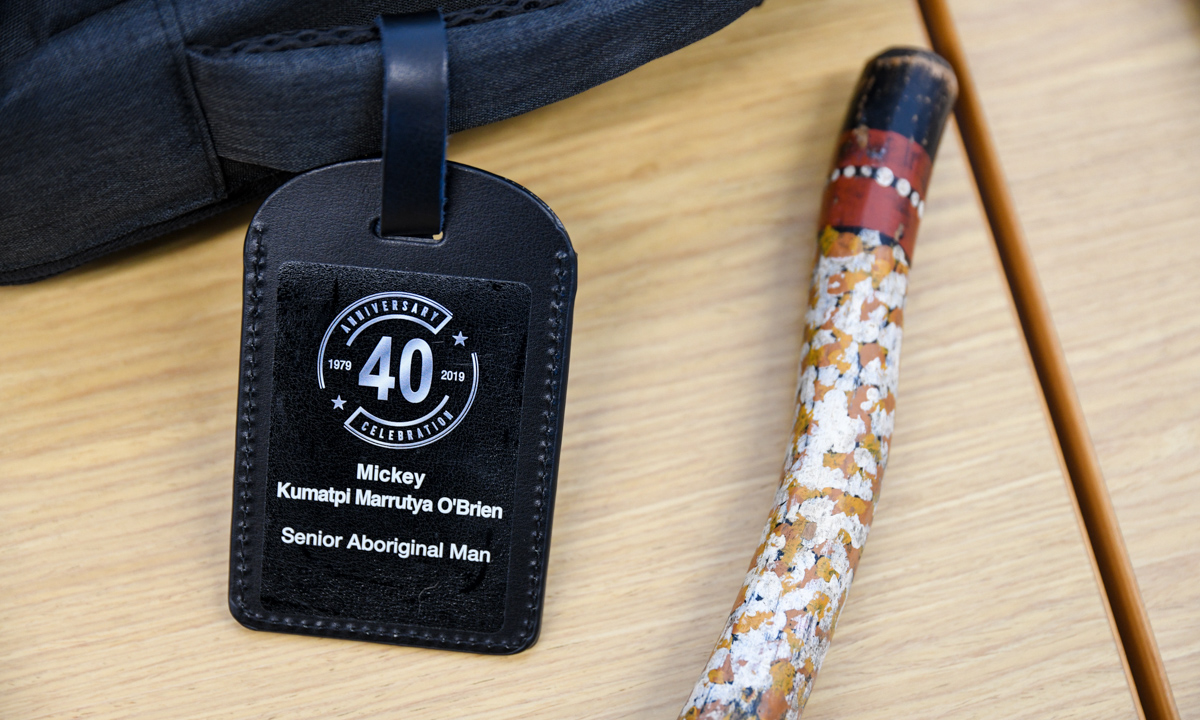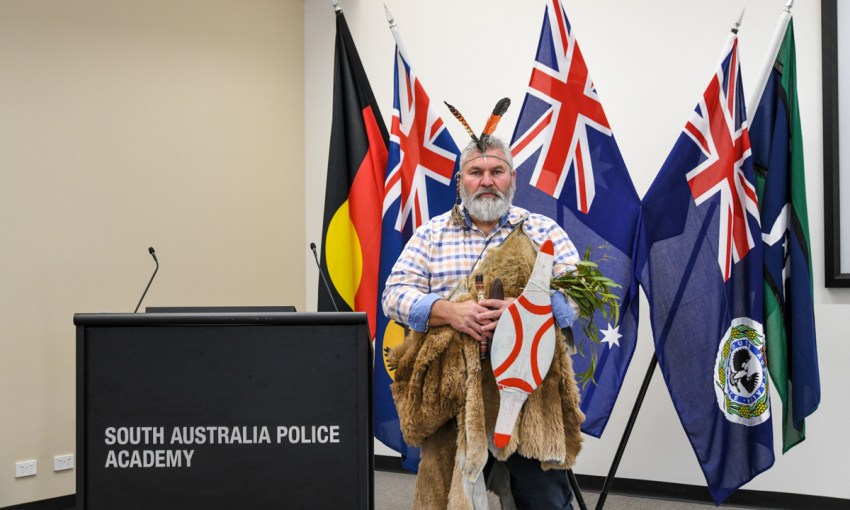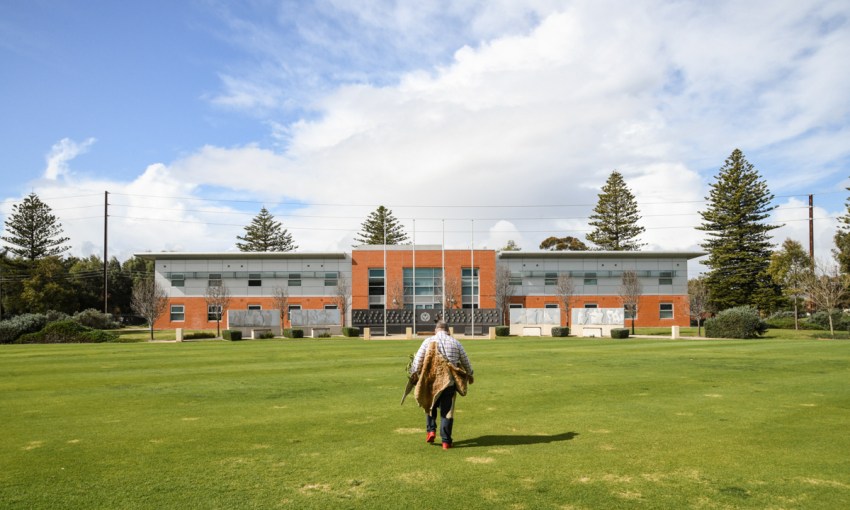As South Australian Police’s first Aboriginal learning and development officer, Uncle Mickey Kumatpi Marrutya O’Brien is helping the large organisation address its failures when policing the state’s Aboriginal community.
Lore man
When 16-year-old Kaurna and Ngadjuri girl Kudnarto married 37-year-old jackaroo Thomas Adams in 1848 at Wongalere, a homestead five kilometres south of what is now Williamstown, the local paper made the comment that she was, “for one of her race, remarkably good looking”. The teen’s grasp of the English language as well as her physical appearance – her neat gown and low boots, which “denoted cleanliness and comfort” – were also lauded.
This was the first marriage between an Aboriginal and a non-Aboriginal person in South Australia. After this earth-shattering event – which required approval by the Chief Protector of Aborigines, Matthew Moorhouse – our state’s interracial marriage “ice” was broken. It emboldened others to “carry their intentions to effect,” the paper reported.
Kudnarto is Uncle Mickey Kumatpi Marrutya O’Brien’s great-great-great-great grandmother. Sitting within a carpeted conference room at the Fort Largs Police Academy, the senior Kaurna and Narungga man brings up this story as an example of Aboriginal people working with the colonial system, not against it.
“Did she do it because she was forced? No, not necessarily,” Uncle Mickey says, taking his Kaurna shield off and placing it on the ground.
“She did those things because our people knew that our life was going to change and you’ve got to, in some ways, be a part of that change as well.” As a result of the marriage, Kudnarto’s name was changed to Mary Anne Adams. She was also given 81 acres of Crown Land.

Uncle Mickey Kumatpi Marrutya O’Brien
Uncle Mickey is the first Aboriginal learning and development officer with the South Australian Police (SAPOL), a position he’s held for two years. He has grand ambitions for his time in the role. There has been pushback from his community, but he wants to rise above it and make change.
“It’s a challenging job because you’re there to change people’s perspectives on how they see culture,” he says. “To me, it’s about what I do, and what I know I do [is] about being strong in your character. And I know that by being here I’m helping policing staff to be more culturally understanding and respectful and valued, and therefore, in turn, that will benefit our community.”
Uncle Mickey took the job of imparting knowledge about First Nations people to 6000 SAPOL staff in 2020. This was the moment the Black Lives Matter movement was at its peak. People around the world were furiously protesting Black deaths in the custody of authorities, of which there have been 516 in Australia since recording began in 1992.
In 2020, SAPOL was also nearing the end of its first Diversity and Inclusion Strategy. This was a plan, in the words of Police Commissioner Grant Stevens, which aimed to create an inclusive workforce. Decades before, in 1991, the final report of the Royal Commission into Aboriginal Deaths in Custody outlined the need for greater Aboriginal participation in policing. It recommended, among 338 other suggestions, the necessity to implement “programs which increase the recruitment of Aboriginal people to the staff of criminal justice agencies” so as to expedite reconciliation and reduce deaths.
SAPOL’s inaugural 2018—2020 diversity document was honest. It laid bare that only 1.1 per cent of the organisation’s staff identified as Aboriginal and Torres Strait Islander. It also mentioned challenges that still remain today, such as the “limited confidence in calling out inappropriate behaviours” among employees, and a lack of “widespread” acceptance of diversity.
The subsequent Diversity and Inclusion Strategy 2021—2025 recorded a 0.6 per cent increase in Aboriginal and Torres Strait Islander staff, which is still 1.3 per cent shy of the national three per cent representation target. Other parts of the report were not so transparent. The first strategy document outlined SAPOL’s deficiencies under an ‘inclusion continuum’ heading, while the current report’s continuum only references successful projects. This includes setting up the Diversity and Inclusion Branch, where Uncle Mickey now works. He confirms he was hired as a result of these reports.
Uncle Mickey says his job is necessary because of the overrepresentation of Indigenous people in the justice system. Recent data from the Australian Bureau of Statistics show that, as of 30 June 2021, Aboriginal and Torres Strait Islander people make up 30 per cent of all prisoners in Australian jails. This is despite them making up 3.8 per cent of the Australian population.
“Police [are] really coming across our people in… daily events,” Uncle Mickey says. “When you have cultural awareness, you then become a little bit more understanding of the situation and the people that you come across in understanding their backgrounds and the impacts. And so, therefore, sometimes you can understand a better way to handle a situation because culture is still very much present in society.”

The intersection of policing and culture
Eye contact is one example. Police training teaches officers if a potential perp doesn’t look them in the eye, they have something to hide. But Uncle Mickey says making direct eye contact is a sign of aggression or disrespect in Aboriginal culture. “They’re showing you respect, because they’re saying, ‘I’m not going to be a person of threat to you, because I’m looking away’,” he says.
Understanding Aboriginal kinship systems, which extend outside of the immediate family, is another important lesson. “Sometimes when you’re dealing with people, you may think you should be dealing with the direct people of that family, but in our system, it’s extendable,” Uncle Mickey says. “In some ways, you know, if you understand that, then you can understand why there’s more people present.”
Knowing these facts is advantageous, but what’s more useful is understanding how a person’s background and personal history can lead them to commit a crime. It’s about taking into account the whole truth, which can stretch back millennia and be woven into cultural lore. It can also be understanding contemporary concepts, such as intergenerational trauma. “There can be so many layers that [represents] an Aboriginal person,” Uncle Mickey says.
While picking up a multicoloured feather that has fallen from his headband, Uncle Mickey says he often tells his cadets about Kulultuwi, a figure from the Munaintya Dreaming creation story. The tale has links to where the Fort Largs Police Academy is located, an area culturally known as Mudlhangga.
Kulultuwi was murdered because of a lack of understanding. “It’s a story about law,” Uncle Mickey says. One of the last great Kaurna leaders, Tjilbruke, was hunting emu. “As an Elder, when you’re hunting, you would have priority over that emu because it takes a while to hunt because you got to track it; you’ve got to then follow it, and you got to trap it.”
While Tjilbruke was stalking the flightless bird around marshy Mudlhangga, he came across his favourite nephew, Kulultuwi. Tjilbruke was tracking the same bird, Uncle Mickey says, “and in law, that’s a no-no”. But because Kulultuwi was his favourite nephew, Tjilbruke tells him to stalk and kill the animal, and the pair will share it.
“But sadly, [Kulultuwi’s] brothers had seen that, through the footprints, that he had taken this emu, and they knew that was [punishable] by law,” Uncle Mickey says. “And so they decided, not knowing that this conversation had gone on, to punish their brother. He was punished and was killed.”
Uncle Mickey acknowledges that, at times, Aboriginal and Torres Strait Islander People interact with police officers and the “situation may not go the way you intend”. He says he doesn’t believe any party is predominantly at fault. But there is a gap in knowledge. Like Tjilbruke and Kulultuwi, there’s a bigger picture.
Not just the law, but the lore.








